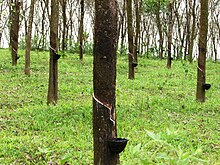Nilambur Kingdom: Difference between revisions
No edit summary |
Samantha kahtraya - clean up vandalism Tags: Mobile edit Mobile web edit |
||
| Line 27: | Line 27: | ||
}} |
}} |
||
'''Nilambur Kingdom''', also known as '''Nilambur Kovilakam''', '''Nilambapuri''', was a former vassal kingdom and royal [[Kovilakam]] in present-day [[Kerala]], [[India]], situated near to the Nilgiri range of the Western Ghats.<ref>Panikkassery, Velayudhan. '' Malabarile Rajavamsangal'', MM Publications (2007), Kottayam India</ref> It was ruled by [[Samantha Kshatriya]]s |
'''Nilambur Kingdom''', also known as '''Nilambur Kovilakam''', '''Nilambapuri''', was a former vassal kingdom and royal [[Kovilakam]] in present-day [[Kerala]], [[India]], situated near to the Nilgiri range of the Western Ghats.<ref>Panikkassery, Velayudhan. '' Malabarile Rajavamsangal'', MM Publications (2007), Kottayam India</ref> It was ruled by [[Samantha Kshatriya]]s who were the family members and representatives of the '''Samoothiri''' ([[Zamorin]]), and also established marriage relations with the [[Nambudiri]]s.<ref>{{Cite book|last=Krishna Iyer|first=K. V.|url=https://archive.org/details/TheZamorinsOfCalicut|title=The Zamorins Of Calicut|date=1938|publisher=Norman Printing Bureau, Calicut}}</ref> They served as vassal kings to the Zamorin, with their capital located 25 kilometers north of [[Manjeri]] in present-day [[Malappuram district]]. They built several aristocratic [[Tharavad]]s, such as the Nambudiri tharavad of Pootheri Illam in [[Feroke]], and married into the Zamorin's own family from [[Nediyiruppu]] Swaroopam. The family-owned Vettakkorumakan Kovil (which is famous for ''Pattutsavam'') and Nilambur Kovilakam itself are situated on the banks of the [[Chaliyar River|Chali river]], and the region is also known for its unique teak plantations, as well as the [[Teak Museum]]. The [[Nilambur – Shoranur Railway Line]] was built by the [[British Raj]] to carry timber and other products from these forests to the outside world. |
||
[[File:Rubber trees in Kerala, India.jpg|left|thumb|Nilambur Rubber Estate]] |
[[File:Rubber trees in Kerala, India.jpg|left|thumb|Nilambur Rubber Estate]] |
||
[[File:NilamburTeak.jpg|left|thumb|The Conolly Teak Plot, named in memory of H.V. Conolly, Malabar District Collector]] |
[[File:NilamburTeak.jpg|left|thumb|The Conolly Teak Plot, named in memory of H.V. Conolly, Malabar District Collector]] |
||
Revision as of 14:47, 5 December 2023
Nilambur Kovilakam Royal family of Nilambur Puthiya Kovilakam | |
|---|---|
 Vettekkorumakan temple | |
| Capital | Nilambur |
| Common languages | Malayalam, English |
| Government | Vassal state |
Nilambur Kingdom, also known as Nilambur Kovilakam, Nilambapuri, was a former vassal kingdom and royal Kovilakam in present-day Kerala, India, situated near to the Nilgiri range of the Western Ghats.[1] It was ruled by Samantha Kshatriyas who were the family members and representatives of the Samoothiri (Zamorin), and also established marriage relations with the Nambudiris.[2] They served as vassal kings to the Zamorin, with their capital located 25 kilometers north of Manjeri in present-day Malappuram district. They built several aristocratic Tharavads, such as the Nambudiri tharavad of Pootheri Illam in Feroke, and married into the Zamorin's own family from Nediyiruppu Swaroopam. The family-owned Vettakkorumakan Kovil (which is famous for Pattutsavam) and Nilambur Kovilakam itself are situated on the banks of the Chali river, and the region is also known for its unique teak plantations, as well as the Teak Museum. The Nilambur – Shoranur Railway Line was built by the British Raj to carry timber and other products from these forests to the outside world.


The area was an ancient tribal settlement, and in Nilambur forests the remains of ancient temples can be found. Cholanaikkans, one of the most primitive tribes in South India and one of the last remaining hunter-gatherer tribes, numbering only 360 in 1991, first contacted in the 1960s, are seen in the Karulai and Chunkathara forest ranges near .
See also
References
- ^ Panikkassery, Velayudhan. Malabarile Rajavamsangal, MM Publications (2007), Kottayam India
- ^ Krishna Iyer, K. V. (1938). The Zamorins Of Calicut. Norman Printing Bureau, Calicut.
External links
